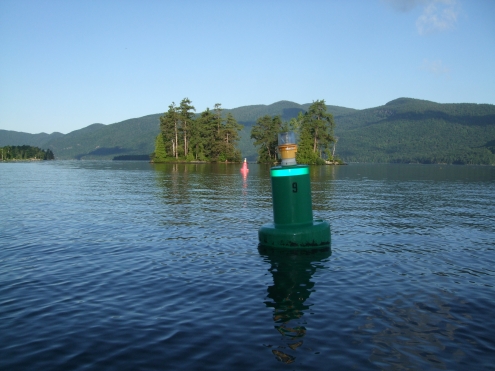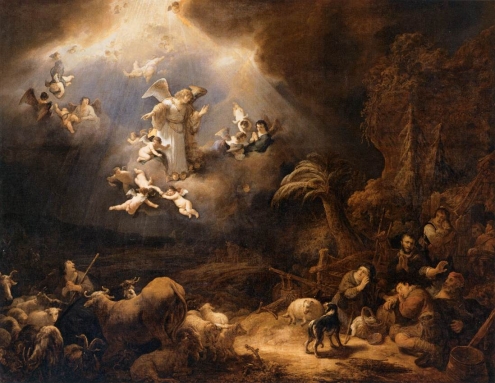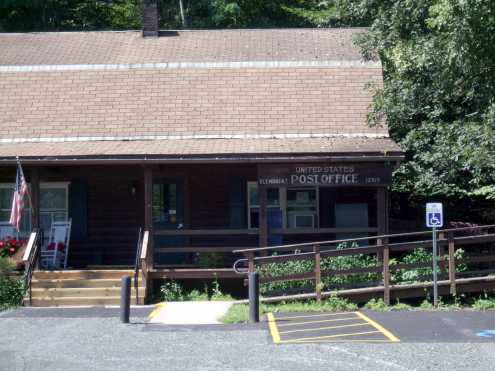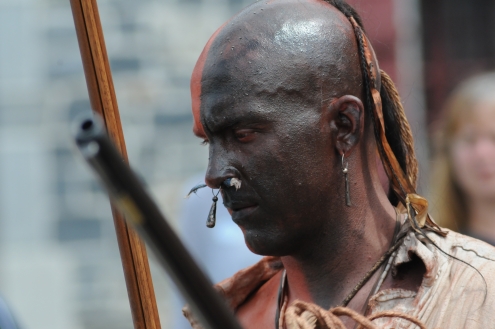
The water off of Huletts Landing was measured to be some of the clearest water in the lake in 2011.
Lake George received the best reading on a measurement for clarity among 98 New York lakes in 2011, the Lake George Association announced today.
“If you want clear water in New York State, Gull Bay on Lake George is the place to be!” said Nancy Mueller, the manager of the NYS Federation of Lake Associations, Inc., the organization sponsoring New York’s Citizens Statewide Lake Assessment Program (CSLAP), in conjunction with the NYS Department of Environmental Conservation. On Lake George, the program has been coordinated by the Lake George Association for the past eight years.
Peter Leyh, an LGA member, was one of several 2011 volunteers to participate in CSLAP. Peter sampled water near Gull Bay on the north end of the lake, and sank a measuring disk for clarity, called a Secchi disk, into the lake. He was able to see the disk in the water at a depth of 11.3 meters on July 5, and he recorded a reading of 11.35 meters on August 22. Both times Peter was able to see the Secchi disk at a depth a little over 37 feet. On August 7, LGA CSLAP volunteers Jack and Cathy LaBombard, who were testing the water near Huletts Landing, recording a reading of 11.24 meters. No other lake participating in the CSLAP program this year could match these readings.
“The rainy, stormy weather had most of the readings across the state down this year– so it was nice to have a few double digit readings. They were hard to come by,” said Mueller.
Readings taken by participants on the LGA’s Floating Classroom showed similar results. “We had some good days on trips for students in the north end of the Lake, and the readings we took near Roger’s Rock were probably close to Peter’s,” said Kristen Rohne, LGA watershed educator.
“While this is great news for Lake George,” said Walt Lender, LGA executive director, “it by no means allows us to relax our efforts to protect the Lake and keep it clean. In fact, it means just the opposite. People need to know that all of these exceptionally clear readings were taken at the north end of the Lake on a perfectly calm day. The clarity and cleanliness in the south end of Lake George, near West Brook, is not anywhere close to this. We have seen a disturbing trend in loss of water clarity and quality from south to north. ”
“This helps keep things in perspective for us,” said Emily DeBolt, LGA director of education. “Yes – lake George is facing many threats – but it is still exceptionally clear, and we are exceptionally lucky. We still have time to work together to protect it and keep it this way for years to come! The key is acting now before it really truly is too late,” she said.
Every summer since 2004, the Lake George Association has coordinated volunteers to assess water quality and clarity through the CSLAP program. The data gathered is used to help manage and assess trends in New York’s many lakes. In addition to CSLAP, the Lake George Association actively encourages adults and children to learn more about lake monitoring and stewardship aboard its Floating Classroom, a specially equipped catamaran which takes groups out on the Lake from May through September.


 Kateri Tekakwitha Rising to Sainthood
Kateri Tekakwitha Rising to Sainthood

 Fort Ticonderoga volunteer BR Delaney portrays a North East Woodland Native at a recent Fort Ticonderoga event. Stuart Lilie, Director of Interpretation at Fort Ticonderoga, will talk about Native Americans and the Patriot Cause as part of the “Fort Fever Series” at Fort Ticonderoga this winter. Photo credit George Jones.
Fort Ticonderoga volunteer BR Delaney portrays a North East Woodland Native at a recent Fort Ticonderoga event. Stuart Lilie, Director of Interpretation at Fort Ticonderoga, will talk about Native Americans and the Patriot Cause as part of the “Fort Fever Series” at Fort Ticonderoga this winter. Photo credit George Jones.
